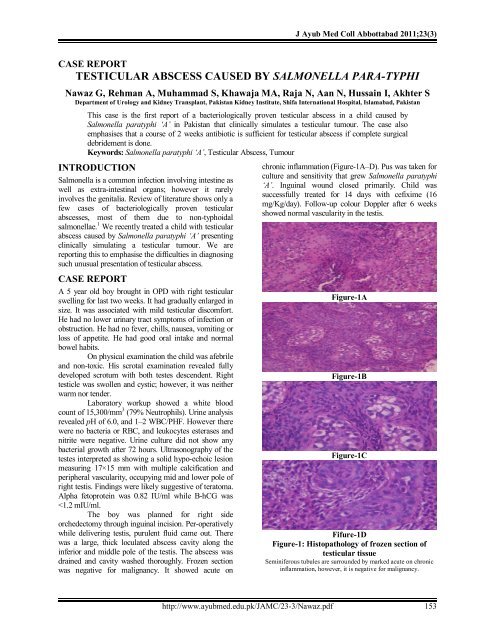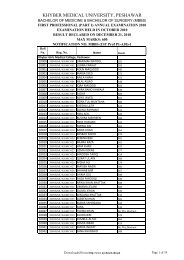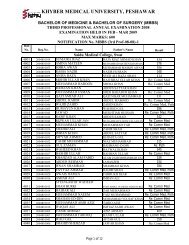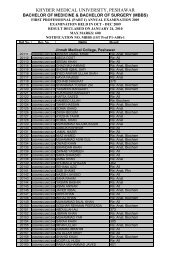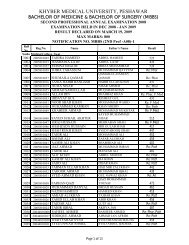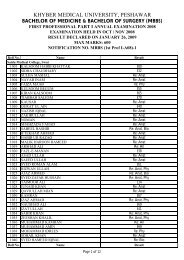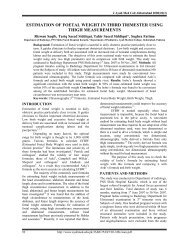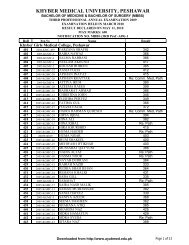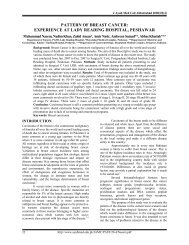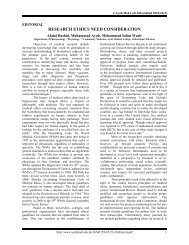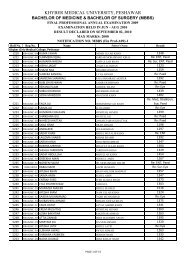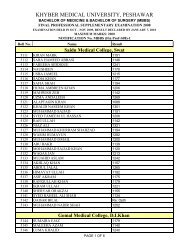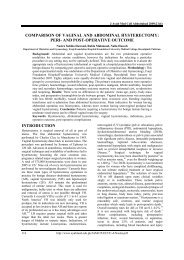TESTICULAR ABSCESS CAUSED BY SALMONELLA PARA-TYPHI
TESTICULAR ABSCESS CAUSED BY SALMONELLA PARA-TYPHI
TESTICULAR ABSCESS CAUSED BY SALMONELLA PARA-TYPHI
Create successful ePaper yourself
Turn your PDF publications into a flip-book with our unique Google optimized e-Paper software.
J Ayub Med Coll Abbottabad 2011;23(3)<br />
CASE REPORT<br />
<strong>TESTICULAR</strong> <strong>ABSCESS</strong> <strong>CAUSED</strong> <strong>BY</strong> <strong>SALMONELLA</strong> <strong>PARA</strong>-<strong>TYPHI</strong><br />
Nawaz G, Rehman A, Muhammad S, Khawaja MA, Raja N, Aan N, Hussain I, Akhter S<br />
Department of Urology and Kidney Transplant, Pakistan Kidney Institute, Shifa International Hospital, Islamabad, Pakistan<br />
This case is the first report of a bacteriologically proven testicular abscess in a child caused by<br />
Salmonella paratyphi ‘A’ in Pakistan that clinically simulates a testicular tumour. The case also<br />
emphasises that a course of 2 weeks antibiotic is sufficient for testicular abscess if complete surgical<br />
debridement is done.<br />
Keywords: Salmonella paratyphi ‘A’, Testicular Abscess, Tumour<br />
INTRODUCTION<br />
Salmonella is a common infection involving intestine as<br />
well as extra-intestinal organs; however it rarely<br />
involves the genitalia. Review of literature shows only a<br />
few cases of bacteriologically proven testicular<br />
abscesses, most of them due to non-typhoidal<br />
salmonellae. 1 We recently treated a child with testicular<br />
abscess caused by Salmonella paratyphi ‘A’ presenting<br />
clinically simulating a testicular tumour. We are<br />
reporting this to emphasise the difficulties in diagnosing<br />
such unusual presentation of testicular abscess.<br />
CASE REPORT<br />
A 5 year old boy brought in OPD with right testicular<br />
swelling for last two weeks. It had gradually enlarged in<br />
size. It was associated with mild testicular discomfort.<br />
He had no lower urinary tract symptoms of infection or<br />
obstruction. He had no fever, chills, nausea, vomiting or<br />
loss of appetite. He had good oral intake and normal<br />
bowel habits.<br />
On physical examination the child was afebrile<br />
and non-toxic. His scrotal examination revealed fully<br />
developed scrotum with both testes descendent. Right<br />
testicle was swollen and cystic; however, it was neither<br />
warm nor tender.<br />
Laboratory workup showed a white blood<br />
count of 15,300/mm 3 (79% Neutrophils). Urine analysis<br />
revealed pH of 6.0, and 1–2 WBC/PHF. However there<br />
were no bacteria or RBC, and leukocytes esterases and<br />
nitrite were negative. Urine culture did not show any<br />
bacterial growth after 72 hours. Ultrasonography of the<br />
testes interpreted as showing a solid hypo-echoic lesion<br />
measuring 17×15 mm with multiple calcification and<br />
peripheral vascularity, occupying mid and lower pole of<br />
right testis. Findings were likely suggestive of teratoma.<br />
Alpha fetoprotein was 0.82 IU/ml while B-hCG was<br />
J Ayub Med Coll Abbottabad 2011;23(3)<br />
DISCUSSION<br />
Although Pakistan is an endemic area for typhoid fever<br />
but testicular involvement is very rare. Previously<br />
reported all cases of testicular involvement by<br />
salmonella were clinically symptomatic. 2–4 In our case,<br />
first the child denied any history of acute scrotum or any<br />
episode of urinary tract infection or gastroenteritis.<br />
Second the child was clinically afebrile and non-toxic<br />
and local examination didn’t reveal any inflammatory<br />
sign. Even ultrasound misled to diagnosis of tumour.<br />
It is important to note that in the literature<br />
prolonged course of antibiotic have been used 1,5 while<br />
we treated successfully with antibiotic for 2 weeks only.<br />
This may be because we had completely removed any<br />
nidus of infection which is main cause of recurrent<br />
infection. 6,7<br />
REFERENCES<br />
1. Conhn JL, Bartlett JI, Corey GR. Extra-intestinal manifestation<br />
of Salmonella infection. Medicine 1987;66:349–88.<br />
2. Svenungsson B. Suppurative epididymo-orchitis due to<br />
salmonella enteritidis. J Infect 1984;8:64–6.<br />
3. Unyyed K, Korman SH, Uromen A. Scrotal abscess with<br />
bacteremia caused by Salmonella group D after ritual<br />
circumcision. Pediatr Infect Dis J 1990;9:65–6.<br />
4. Kostalas G, Thomas E. Orchitis and testicular abscess formation<br />
as complication of Salmonella Virchow gastroenteritis. Med J<br />
Aust 1973;60:769–70.<br />
5. Huth RG, Goldstein E. Testicular abscess caused by Salmonella<br />
typhi. South Med J 1991;84(9):1156–7.<br />
6. Gerridzen RG, Ooi TC, Mc Kendry JBR. Salmonella<br />
epididymitis with recurrent septicemia in a diabetic patient.<br />
Urology 1981;17:172–4.<br />
7. Greene JB, Adler M, Holzman RS. Salmonella enteritidis<br />
genitourinary tract infection in a homosexual man. J Urol<br />
1982;128:1046–7.<br />
Address for Correspondence:<br />
Dr. Gul Nawaz, Department of Urology and Kidney Transplant, Pakistan Kidney Institute, Shifa International<br />
Hospital, Sector H-8/4, Islamabad, Pakistan. Cell: +92-333-9587373<br />
Email: drgul2006@yahoo.com<br />
154<br />
http://www.ayubmed.edu.pk/JAMC/23-3/Nawaz.pdf


